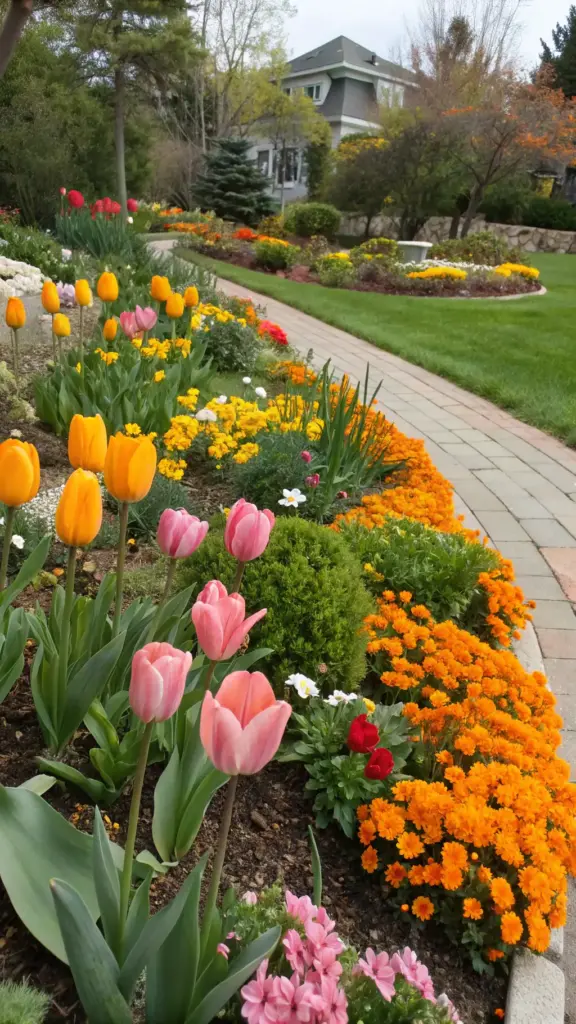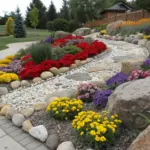10. Seasonal Rotating Display

There’s something magical about a garden that evolves with the seasons—it’s like having a living calendar right in your backyard. I’ll never forget the first time I swapped out my spring tulips for summer marigolds. It felt like giving my garden a fresh start, and honestly, it kept me excited about gardening all year long. If you’re looking to create a seasonal rotating display, this is your ultimate guide to planning ahead for year-round beauty while keeping things budget-friendly. Let’s dive in!
Why Seasonal Swaps Keep Your Garden Exciting
One of the biggest mistakes I made early on was planting perennials and calling it a day. Don’t get me wrong—perennials are great—but they don’t offer the same dynamic flair as seasonal flowers. By swapping out blooms like tulips in spring, zinnias in summer, mums in fall, and even winter pansies, you can keep your garden looking fresh and vibrant no matter the season.
I once hosted a small outdoor gathering in October, and my garden was bursting with golden mums and deep red asters. My guests couldn’t stop complimenting how “alive” everything felt—even as the weather cooled down. It’s all about staying in sync with nature, and seasonal swaps let you do just that.
How to Plan Ahead for Year-Round Beauty
The secret to a successful seasonal rotating display is planning. Start by mapping out which flowers will shine in each season. For example:
- Spring: Tulips, daffodils, and hyacinths bring bright pops of color after winter.
- Summer: Sunflowers, zinnias, and petunias thrive in the heat.
- Fall: Mums, asters, and ornamental kale add rich autumnal hues.
- Winter: Pansies, hellebores, and evergreen shrubs keep things lively even in colder months.
I learned this lesson the hard way when I forgot to prep for fall and ended up with a sad, empty flower bed. Now, I make it a habit to jot down a seasonal planting schedule at the start of each year. Trust me, it saves so much stress later on.
Pro tip: Use container gardens for your seasonal flowers. This makes it easy to swap them out without disturbing your permanent plants or soil.
Budget-Friendly Shopping at Local Nurseries
Let’s talk money because, let’s face it, gardening can get expensive if you’re not careful. One of my favorite tricks is shopping at local nurseries toward the end of the season. That’s when they often discount plants to make room for new stock. Last fall, I snagged a bunch of mums for half price—they looked just as gorgeous as the full-price ones I’d bought earlier in the year.
Another tip? Buy bulbs in bulk during sales and store them until planting time. I once scored a bag of tulip bulbs for 75% off and had enough to fill two entire beds. Plus, local nurseries often have native plants that are better suited to your climate, saving you money on maintenance in the long run.
It’s all about being smart with your resources, so don’t be afraid to shop around or wait for deals.
Tips for Seamless Seasonal Transitions
To make your seasonal rotating display look effortless, focus on consistency in your design. For example, use the same pots or planters throughout the year but switch out the flowers inside them. This creates a cohesive look while still allowing for seasonal variety.
Another idea? Add evergreen elements like boxwood shrubs or ornamental grasses as a backdrop for your seasonal blooms. These stay green year-round and provide structure to your garden, no matter what’s planted around them.
And here’s a little secret: mulch is your best friend. A fresh layer of mulch before each season makes everything look polished and intentional—even if you’ve just thrown in a few bargain plants.
Conclusion
Ready to roll up your sleeves and transform your yard into a floral masterpiece? These 10 DIY flower garden ideas are designed to spark creativity while catering to your diverse interests—from art and design to parenting and wellness. So grab your gloves, pick your favorite idea, and let’s make magic happen! Don’t forget to share your creations with us—we’d love to see what you come up with. Happy gardening!









GIPHY App Key not set. Please check settings